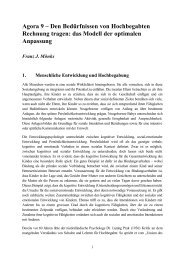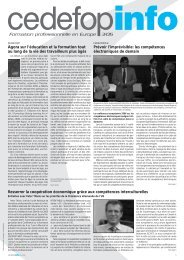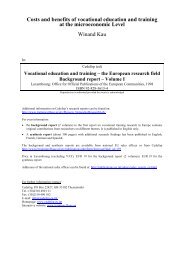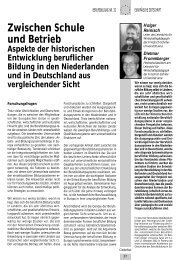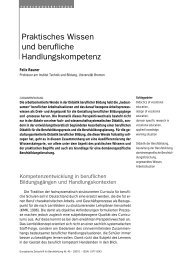Full text (pdf) - Cedefop - Europa
Full text (pdf) - Cedefop - Europa
Full text (pdf) - Cedefop - Europa
You also want an ePaper? Increase the reach of your titles
YUMPU automatically turns print PDFs into web optimized ePapers that Google loves.
196<br />
European journal of vocational training<br />
No 42/43 – 2007/3 2008/1<br />
ever, and credit points are not deducted or added if more time or less is taken<br />
(see SCQF 2003).<br />
The problem of defining credit points nevertheless becomes apparent when<br />
one examines the implementation of ECTS in the higher education sector.<br />
Reichert and Tauch (2005) point out in their survey that higher education establishments<br />
still have difficulty with workload-based calculations. Furthermore,<br />
the calculation of credits on the basis of study programmes can in some<br />
cases lead to a variation in the number of credit points for one and the same<br />
course of study. The proposed method of calculating credits in the ECVET<br />
con<strong>text</strong> states that ‘120 ECVET credit points on average could be associated<br />
to the learning outcomes achieved by an individual in a year in a formal<br />
full time VET con<strong>text</strong>’ (European Commission, 2006b, p. 14). However, several<br />
methods are possible at national level for determining the number of credit<br />
points to be allocated: ‘the number of credit points allocated to a qualification<br />
and units can be determined on the base of the following criteria:<br />
the contents of a qualification in terms of range and/or volume of knowledge,<br />
skills and wider competences to be acquired;<br />
with reference to a notional average length of programme leading to such<br />
a qualification;<br />
by the amount of notional learning activities and workload necessary for<br />
a learner to attain the set of learning outcomes corresponding to a part or<br />
whole qualification (e.g. regarding a typical training programme or a training<br />
programme of reference)’ (European Commission, 2005a, p. 14).<br />
The difficulty of making the two credit systems compatible becomes palpable<br />
with respect to the composition, calculation and allocation of credits.<br />
The fundamental difference between ECTS and ECVET lies in their primary<br />
orientation: ECVET units and credits are defined in relation to qualifications<br />
and the associated learning outcomes; ECTS on the other hand is oriented<br />
according to study programmes. Concerning their secondary orientation, ECVET<br />
relies for example on training regulations or overall curricula, whereas in ECTS<br />
learning outcomes are associated with the definition of learning objectives.<br />
This distinction is clarified in the following diagram.






